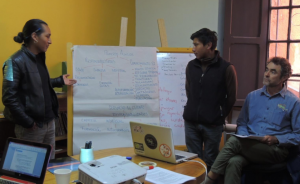 Ana Ines Figueroa, owner and lead guide for Adventure & Landscape (Argentina) and Stephen Taranto, co-owner and Director of Programs for La Paz on Foot (Bolivia) recently collaborated on a half-day workshop for La Paz on Foot guides and staff, focusing on ATTA’s newly minted Adventure Guide Standard. The workshop was the team’s first effort to share the standard with working guides and the results were positive.
Ana Ines Figueroa, owner and lead guide for Adventure & Landscape (Argentina) and Stephen Taranto, co-owner and Director of Programs for La Paz on Foot (Bolivia) recently collaborated on a half-day workshop for La Paz on Foot guides and staff, focusing on ATTA’s newly minted Adventure Guide Standard. The workshop was the team’s first effort to share the standard with working guides and the results were positive.
Both Figueroa and Taranto were active members of the Adventure Guide Standard Working Group, a cohort of industry professionals charged with creating the industry’s first International Adventure Travel Guide Qualifications and Performance Standard. This group has now evolved into a Governance Board, tasked with conducting outreach and facilitating revisions to the international standard. This process was facilitated by the ATTA and is now led by interim chair, Dan Moore of Pandion Consulting & Facilitation. Ana Ines and Stephen’s busy travel schedules overlapped in La Paz just before Ana Ines was set to guide clients across Bolivia to San Pedro de Atacama, and they decided to take advantage of being in the same place at the same time and with a shared understanding of the processes that resulted in the Standard and the realities of local adventure guides in the Andean region.
Guides have a crucial role in making a trip successful and safe, and of course memorable and fun. It is important they know what is expected of them, and for business owners, to understand what they must look for when hiring new guides. As most of us working in adventure travel know, except for specialized technical training and certification, adventure travel guiding is often a self-taught career. What training and certification does is exist is not always available or too expensive for local guides in many adventure destinations.
Indeed, many guides (and their parents!) see the work as temporary, helpful to pay for their studies or support their hobby as a mountaineer. Many adventure guides have never considered their work as a professional career that can and needs to be continually improved and evaluated. Enter the Adventure Guide Standard!
“The Adventure Guide Standard lays out a practical, basic skills set that active and in-training adventure guides can develop, improve, complement and maintain” explained Taranto.
“Exactly,” echoed Figueroa, adding that “they are especially useful because as operators the standard helps us communicate to our guides what we - and our clients - expect of them and they, in turn, know in what areas they should be able to demonstrate competency.”
The Adventure Guide Standard was only recently approved in its current form by the Adventure Guide Standard Governance Board, a committee with representation from all continents and regions and charged with overseeing the use of the standard, among other responsibilities. The Standard is now in an initial implementation phase and the La Paz workshop was the very first effort to “bring the standard home.”
The workshop gave two of the Governance Board’s members an opportunity to directly share the document with guides, explain its history and utility and go through the document competency by competency, a unique experience that should serve to guide its implementation throughout the ATTA community.
After the workshop, Figueroa commented that “working with La Paz on Foot’s guides and getting a sense of each one’s experiences, skills levels and motivations for being an adventure guide made clear that the Standard is very helpful to use as an initial platform upon which future training can be sought by or offered to adventure guides.”
“Additionally,” observed Naira Sandoval, a La Paz on Foot guide in her second year of work, “it clearly lays out what the basic skills are that we should have, or work towards having. As a new guide I am often unsure if I have all the capacities that I need to provide safe and engaging services to my clients and the Standard showed me where I need to improve.”
Taranto and Figueroa hope that this will not be the last time they co-facilitate a workshop on the Standard in their region. After many years working in the Andes they understand the challenges faced by guides themselves and the companies that hire them to provide high-quality, professional services that showcase the best of their destinations and highlight the positive contributions that tourism can make to them.
And while the Adventure Guide Standard does not aim to homogenize the creative and locally-adapted practices of adventure guides around the world, it is an important step towards the development of a universal language for the critical work they do as cultural ambassadors and stewards of the landscapes where they practice their arts.
